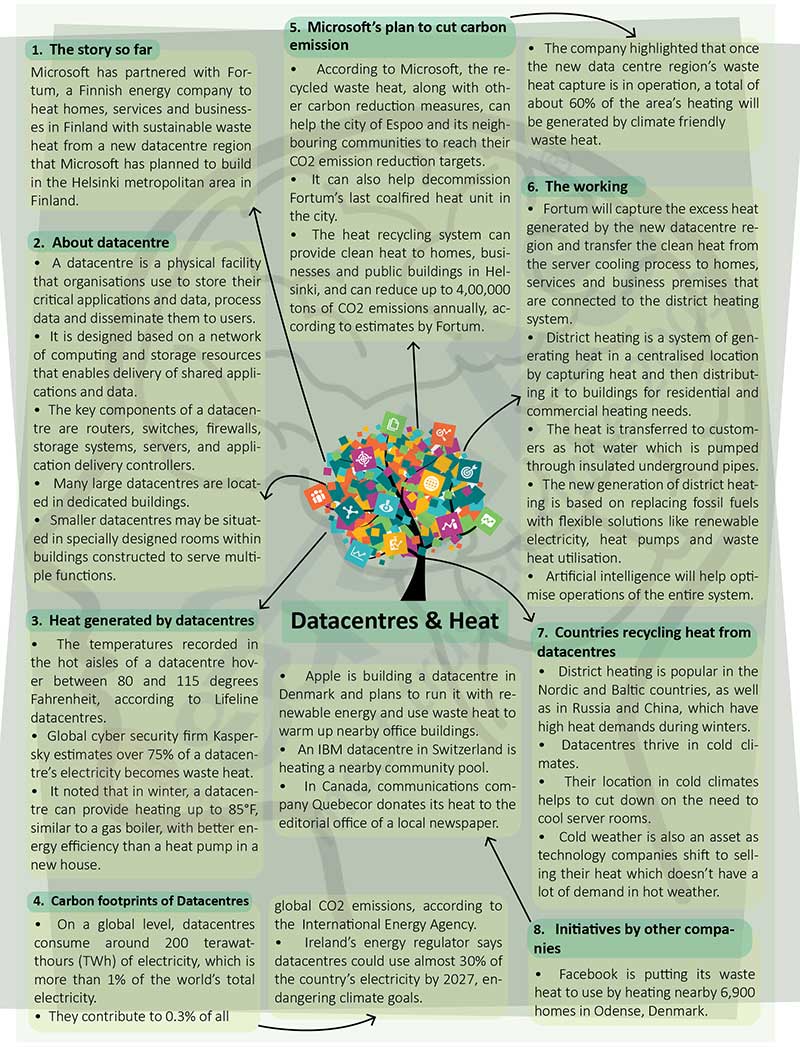Brain-booster
/
13 Apr 2022
Brain Booster for UPSC & State PCS Examination (Topic: Datacentres & Heat)

The story so far
- Microsoft has partnered with Fortum, a Finnish energy company to heat
homes, services and businesses in Finland with sustainable waste heat from a
new datacentre region that Microsoft has planned to build in the Helsinki
metropolitan area in Finland.
About datacentre
- A datacentre is a physical facility that organisations use to store
their critical applications and data, process data and disseminate them to
users.
- It is designed based on a network of computing and storage resources
that enables delivery of shared applications and data.
- The key components of a datacentre are routers, switches, firewalls,
storage systems, servers, and application delivery controllers.
- Many large datacentres are located in dedicated buildings.
- Smaller datacentres may be situated in specially designed rooms within
buildings constructed to serve multiple functions.
Heat generated by datacentres
- The temperatures recorded in the hot aisles of a datacentre hover
between 80 and 115 degrees Fahrenheit, according to Lifeline datacentres.
- Global cyber security firm Kaspersky estimates over 75% of a
datacentre’s electricity becomes waste heat.
- It noted that in winter, a datacentre can provide heating up to 85°F,
similar to a gas boiler, with better energy efficiency than a heat pump in a
new house.
Carbon footprints of Datacentres
- On a global level, datacentres consume around 200 terawatthours (TWh) of
electricity, which is more than 1% of the world’s total electricity.
- They contribute to 0.3% of all global CO2 emissions, according to the
International Energy Agency.
- Ireland’s energy regulator says datacentres could use almost 30% of the
country’s electricity by 2027, endangering climate goals.
Microsoft’s plan to cut carbon emission
- According to Microsoft, the recycled waste heat, along with other carbon
reduction measures, can help the city of Espoo and its neighbouring
communities to reach their CO2 emission reduction targets.
- It can also help decommission Fortum’s last coalfired heat unit in the
city.
- The heat recycling system can provide clean heat to homes, businesses
and public buildings in Helsinki, and can reduce up to 4,00,000 tons of CO2
emissions annually, according to estimates by Fortum.
- The company highlighted that once the new data centre region’s waste
heat capture is in operation, a total of about 60% of the area’s heating
will be generated by climate friendly waste heat.
The working
- Fortum will capture the excess heat generated by the new datacentre
region and transfer the clean heat from the server cooling process to homes,
services and business premises that are connected to the district heating
system.
- District heating is a system of generating heat in a centralised
location by capturing heat and then distributing it to buildings for
residential and commercial heating needs.
- The heat is transferred to customers as hot water which is pumped
through insulated underground pipes.
- The new generation of district heating is based on replacing fossil
fuels with flexible solutions like renewable electricity, heat pumps and
waste heat utilisation.
- Artificial intelligence will help optimise operations of the entire
system.
Countries recycling heat from datacentres
- District heating is popular in the Nordic and Baltic countries, as well
as in Russia and China, which have high heat demands during winters.
- Datacentres thrive in cold climates.
- Their location in cold climates helps to cut down on the need to cool
server rooms.
- Cold weather is also an asset as technology companies shift to selling
their heat which doesn’t have a lot of demand in hot weather.
Initiatives by other companies
- Facebook is putting its waste heat to use by heating nearby 6,900 homes
in Odense, Denmark.
- Apple is building a datacentre in Denmark and plans to run it with
renewable energy and use waste heat to warm up nearby office buildings.
- An IBM datacentre in Switzerland is heating a nearby community pool.
- In Canada, communications company Quebecor donates its heat to the
editorial office of a local newspaper.







